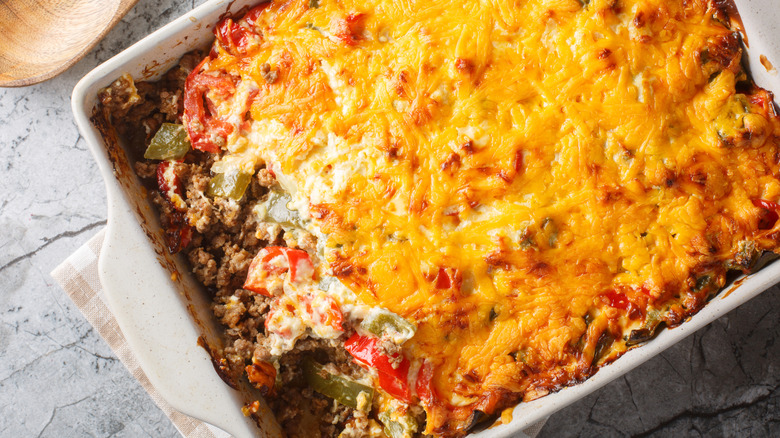This Once-Popular Casserole Is The Epitome Of Depression-Era Cooking
When times are tough, culinary innovation takes place. From Italy's flavor-optimizing cucina povera to the complicated history of budae jjigae, abundant examples exist worldwide. And in the U.S., the Great Depression era in particular gave rise to a wide breadth of cost-effective classics. Specifically, dishes like the shipwreck casserole proliferated during such penny-pinching times, using starchy ingredients to ease meal creation for the whole family.
The beauty of a casserole recipe is its malleability; shift just one or two cornerstone components, and a new dish identity emerges. Oftentimes, such tinkering is accompanied by a unique name — think million dollar chicken casserole. So when you hear of a dish name like shipwreck casserole, you know it's another Great Depression classic.
Foundationally, the dish consists of ground beef layered over potatoes, and topped with a tomato sauce. The dish can be flavored with any number of aromatics, like onions, peppers, and garlic, and spices like cumin or paprika. As with most casserole recipes, a layer of cheese on top seals the deal. Slow-cooked for upwards of two hours, it's a hearty creation that satiates come dinnertime.
Why is it called shipwreck casserole?
Besides the food's Great Depression era origins, not much is known regarding the shipwreck casserole's creation. Most often, the dish's name is interpreted as a reference to its utilitarian composition; any available ingredients can be combined. Others humorously suggest the casserole's jumbled final appearance lends the moniker. And just like its diverse composition, the dish's name changes, too — you'll also find it called shipwreck dinner or shipwreck skillet.
Regardless, the shipwreck casserole lends an easy-to-follow template that's proved dependable for decades. While thin potato slices typically form the starchy foundation of the dish, rice or similar substitutes like pasta (especially macaroni shaped) and hash browns are often used, making the dish similar to a tater tot casserole.
Kidney beans add extra satiation in many recipes, and any available vegetables — corn, broccoli, peas, carrots, or celery – can be incorporated, too. As a meal born amidst difficult times, the amount of available beef determines the quantity of complementing ingredients you'll need.


